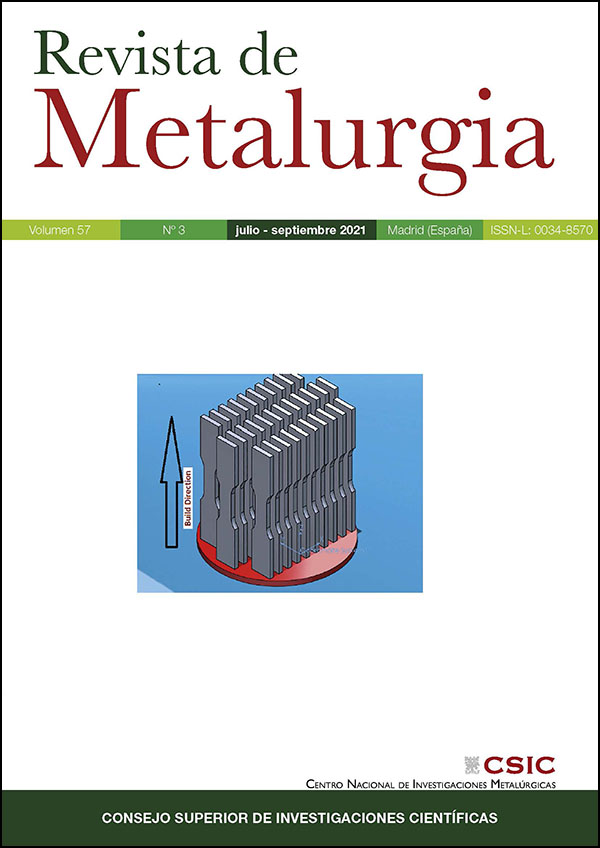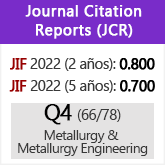La eliminación de metales tóxicos presentes en efluentes líquidos mediante resinas de cambio iónico. Parte XVI: Iron(III)/H+/Lewatit TP208
DOI:
https://doi.org/10.3989/revmetalm.203Palabras clave:
Efluentes líquidos, Eliminación, Hierro(III), Lewatit TP208, Nanotubos de carbono de pared múltipleResumen
Se ha empleado la resina de cambio iónico Lewatit TP208 en la eliminación de Fe(III) de disoluciones acuosas bajo distintas condiciones experimentales: velocidad de agitación aplicada al sistema, pH del medio acuoso y dosificación de la resina, temperatura y concentración de hierro(III) en la disolución acuosa. Se obtiene un máximo en la carga de hierro(III) en la resina empleando una velocidad de agitación de 900 min-1, siendo este proceso de carga del metal dependiente del valor del pH dela disolución acuosa y de la dosificación de la resina. El aumento de la temperatura da lugar a una disminución de la carga de hierro(III) en la resina, resultando en un proceso endotérmico. La eliminación de Fe(III) de la disolución acuosa también depende da la concentración inicial de este elemento en la misma. Se ha investigado el proceso de carga de Fe(III) en la resina en presencia (disoluciones binarias) de otros elementos metálicos en la disolución: Cu(II), Zn(II), Cr(III), In(III), y también se ha comparado con la carga de Fe(II) en la resina Lewatit TP208. Asimismo, se compara el uso de la resina con el empleo de nanotubos de carbono de pared múltiple en la eliminación de Fe(III) de la disolución acuosa. El hierro(III) cargado en la resina se puede eluir empleando disoluciones ácidas.
Descargas
Citas
Al-Ghamdi, Y.O., Alamry, K.A., Hussein, M.A., Marwani, H.M., Asiri, A.M. (2019). Sulfone-modified chitosan as selective adsorbent for the extraction of toxic Hg(II) metal ions. Adsorpt. Sci. Technol. 37 (1-2), 139-159. https://doi.org/10.1177/0263617418818957
Alguacil, F.J., Coedo, A.G., Dorado, T., Padilla, I. (2002). The removal of toxic metals from liquid effluents by ion exchange resins. Part I: chromium(VI)/sulphate/Dowex 1x8. Rev. Metal. 38, 306-311. https://doi.org/10.3989/revmetalm.2002.v38.i4.412
Alguacil, F.J. (2002). The removal of toxic metals from liquid effluents by ion exchange resins. Part II: cadmium(II)/sulphate/Lewatit TP260. Rev. Metal. 38 (5), 348-352. https://doi.org/10.3989/revmetalm.2002.v38.i5.418
Alguacil, F.J. (2003). The removal of toxic metals from liquid effluents by ion exchange resins. Part III: copper(II)/sulphate/Amberlite 200. Rev. Metal. 39 (3), 205-209. https://doi.org/10.3989/revmetalm.2003.v39.i3.330
Alguacil, F.J., Lopez, F.A., Rodriguez, O., Martinez-Ramirez, S., Garcia-Diaz, I. (2016). Sorption of indium (III) onto carbon nanotubes. Ecotox. Environ. Safety 130, 81-86. https://doi.org/10.1016/j.ecoenv.2016.04.008 PMid:27085001
Alguacil, F.J. (2017a). The removal of toxic metals from liquid effluents by ion exchange resins. Part IV: chromium(III)/H+/Lewatit SP112. Rev. Metal. 53 (2), e093.
Alguacil, F.J. (2017b). The removal of toxic metals from liquid effluents by ion exchange resins. Part V: nickel(II)/H+/Dowex C400. Rev. Metal. 53 (4), e105.
Alguacil, F.J., Garcia-Diaz, I., Lopez, F., Rodriguez, O. (2017). Removal of Cr(VI) and Au(III) from aqueous streams by the use of carbon nanoadsorption technology. Desal. Water Treat. 63, 351-356. https://doi.org/10.5004/dwt.2017.0264
Alguacil, F.J. (2018a). The removal of toxic metals from liquid effluents by ion exchange resins. Part VI: manganese(II)/H+/Lewatit K2621. Rev. Metal. 54 (2), e116.
Alguacil, F.J. (2018b). The removal of toxic metals from liquid effluents by ion exchange resins. Part VII: manganese(VII)/H+/Amberlite 958. Rev. Metal. 54 (3), e125.
Alguacil, F.J., Escudero, E. (2018). The removal of toxic metals from liquid effluents by ion exchange resins. Part VIII: arsenic(III)/OH/Dowex 1x8. Rev. Metal. 54 (4), e132.
Alguacil, F.J. (2019a). The removal of toxic metals from liquid effluents by ion exchange resins. Part IX: lead(II)/H+/Amberlite IR120. Rev. Metal. 55 (1), e138.
Alguacil, F.J. (2019b). The removal of toxic metals from liquid effluents by ion exchange resins. Part X: antimony(III)/H+/Ionac SR7. Rev. Metal. 55 (3), e152.
Alguacil, F.J. (2019c). The removal of toxic metals from liquid effluents by ion exchange resins. Part XI: cobalt(II)/H+/Lewatit TP260. Rev. Metal. 55 (4), e154.
Alguacil, F.J., Escudero, E. (2020). The removal of toxic metals from liquid effluents by ion exchange resins. Part XII: mercury(II)/H+/Lewatit SP112. Rev. Metal. 56 (1), e160.
Alguacil, F.J. (2020a). The removal of toxic metals from liquid effluents by ion exchange resins. Part XIII: zinc(II)/H+/ Lewatit OC-1026 Rev. Metal. 56 (3), e172.
Alguacil, F.J. (2020b). The removal of toxic metals from liquid effluents by ion exchange resins. Part XIV: indium(III)/H+/Dowex-400. Rev. Metal. 56 (4), e184.
Alguacil, F.J. (2021). The removal of toxic metals from liquid effluents by ion exchange resins. Part XV: iron(II)/H+/Lewatit TP208. Rev. Metal. 57 (1), e190. https://doi.org/10.3989/revmetalm.190
Arzate, S., Campos-Mañas, M.C., Miralles-Cuevas, S., Agüera, A., García Sánchez, J.L., Sánchez Pérez, J.A. (2020). Removal of contaminants of emerging concern by continuous flow solar photo-Fenton process at neutral pH in open reactors. J. Environ. Managem. 261, 110265. https://doi.org/10.1016/j.jenvman.2020.110265 PMid:32148322
Bakalár, T., Kaňuchová, M., Girová, A., Pavolová, H., Hromada, R., Hajduová, Z. (2020). Characterization of Fe(III) adsorption onto zeolite and bentonite. Int. J. Environ. Res. Public Health 17 (16), 5718. https://doi.org/10.3390/ijerph17165718 PMid:32784702 PMCid:PMC7460527
Caravaca, C., Cobo, A., Alguacil, F.J. (1994). Considerations about the recycling of EAF flue dusts as source for the recovery of valuable metals by hydrometallurgical processes. Resour. Conserv. Recycl. 10 (1-2), 35-41. https://doi.org/10.1016/0921-3449(94)90036-1
Dauletbay, A. Serikbayev, B.A., Kamysbayev, D.K., Kudreeva, L.K. (2020). Interaction of metal ions with humic acids of brown coals of Kazakhstan. J. Exp. Nanosci. 15 (1), 406-416. https://doi.org/10.1080/17458080.2020.1810240
El-Hamid, A.M.A., Zahran, M.A., Ahmed, Y.M.Z., El-Sheikh, S.M. (2020). Separation of heavy metal ions from petroleum ash liquor using organic resins and FT-IR study of the process. Radiochemistry 62, 243-250. https://doi.org/10.1134/S1066362220020125
Flieger, J., Kawka, J., Płaziński, W., Panek, R., Madej, J. (2020). Sorption of heavy metal ions of chromium, manganese, selenium, nickel, cobalt, iron from aqueous acidic solutions in batch and dynamic conditions on natural and synthetic aluminosilicate sorbents. Materials 13 (22), 5271. https://doi.org/10.3390/ma13225271 PMid:33233399 PMCid:PMC7700620
Geissler, C., Singh, M. (2011). Iron, meat and health. Nutrients 3 (3), 283-316. https://doi.org/10.3390/nu3030283 PMid:22254098 PMCid:PMC3257743
Hamad, A.A., Hassouna, M.S., Shalaby, T.I., Elkady, M.F., Abd Elkawi, M.A., Hamad, H.A. (2020). Electrospun cellulose acetate nanofiber incorporated with hydroxyapatite for removal of heavy metals. Int. J. Biol. Macromol. 151, 1299-1313. https://doi.org/10.1016/j.ijbiomac.2019.10.176 PMid:31751727
Hamza, M.F., Wei, Y., Benettayeb, A., Wang, X.P., Guibal, E. (2019). Efficient removal of uranium, cadmium and mercury from aqueous solutions using grafted hydrazide-micro-magnetite chitosan derivative. J. Mater. Sci. 55, 4193-4212. https://doi.org/10.1007/s10853-019-04235-8
López Díaz-Pavon, A., Cerpa, A., Alguacil, F.J. (2014). Processing of indium(III) solutions via ion exchange with Lewatit K-2621 resin. Rev. Metal. 50 (2), e010. https://doi.org/10.3989/revmetalm.010
Mohaghehian, A., Pourmosheni, M., Vahidi-Kolur, R., Yang, J.-K., Shirzad-Siboni, M. (2017). Preparation and characterization of kaolin coated with Fe3O4 nanoparticles for the removal of hexavalent chromium: kinetic, equilibrium and thermodynamic studies. Desal. Water Treat. 90, 262-272. https://doi.org/10.5004/dwt.2017.21426
Nagla, R.E., Arab, T.T., Greenwood, M.T. (2017). Iron mediated toxicity and programmed cell death: A review and a re-examination of existing paradigms. Biochim. Biophys. Acta-Molecular Cell Res. 1864 (2), 399-430. https://doi.org/10.1016/j.bbamcr.2016.12.002 PMid:27939167
Recalcati, S., Minotti, G., Cairo, G. (2010). Iron regulatory proteins: from molecular mechanisms to drug development. Antiox. Redox Sign. 13 (10), 1593-1616. https://doi.org/10.1089/ars.2009.2983 PMid:20214491
USEPA (2004). Iron. U.S. Environmental Protection Agency. EPA/600/1-78/017, Washington, D.C.
USEPA (2020) Secondary drinking water standards: guidance for nuisance chemicals. U.S. Environmental Protection Agency. Accessed June 2021. www.epa.gov. https://www.epa.gov/sdwa/secondary-drinking-water-standards-guidance-nuisance-chemicals.
Wang, L., Wang, Y., Cui, L., Gao, J., Guo, Y., Cheng, F. (2020). A sustainable approach for advanced removal of iron from CFA sulfuric acid leach liquor by solvent extraction with P507. Sep. Purif. Technol. 251, 117371. https://doi.org/10.1016/j.seppur.2020.117371
Zhang, X., Zhou, K., Wu, Y., Lei, Q., Peng, C., Chen, W. (2020). Separation and recovery of iron and scandium from acid leaching solution of red mud using D201 resin. J. Rare Earths 38 (12), 1322-1329. https://doi.org/10.1016/j.jre.2019.12.005
Zhu, K., Ren, X., Li, H., Wei, Q. (2021). Simultaneous extraction of Ti(IV) and Fe(III) in HCl solution containing multiple metals and the mechanism research. Sep. Purif. Technol. 257, 117897 https://doi.org/10.1016/j.seppur.2020.117897
Publicado
Cómo citar
Número
Sección
Licencia
Derechos de autor 2021 Consejo Superior de Investigaciones Científicas (CSIC)

Esta obra está bajo una licencia internacional Creative Commons Atribución 4.0.
© CSIC. Los originales publicados en las ediciones impresa y electrónica de esta Revista son propiedad del Consejo Superior de Investigaciones Científicas, siendo necesario citar la procedencia en cualquier reproducción parcial o total.Salvo indicación contraria, todos los contenidos de la edición electrónica se distribuyen bajo una licencia de uso y distribución “Creative Commons Reconocimiento 4.0 Internacional ” (CC BY 4.0). Puede consultar desde aquí la versión informativa y el texto legal de la licencia. Esta circunstancia ha de hacerse constar expresamente de esta forma cuando sea necesario.
No se autoriza el depósito en repositorios, páginas web personales o similares de cualquier otra versión distinta a la publicada por el editor.


















